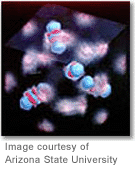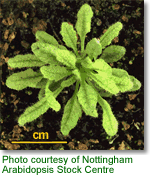 |
 This Just In ... This Just In ...
|
| |
Unique Public-Private Partnership Announces
Science Challenge to America's Youth
A unique alliance of government, public and private organizations today unveiled
"JumpStart 2000, Your Chance to Build a Better
Century," the largest appeal ever to the nation's
youth to use science and technology to create real
solutions for a better life in the 21st century. JumpStart
2000 is a national science and technology challenge
for students in grades K-12. Developed and sponsored
by PARADE and react magazines, the National
Science Board, the governing board of the National
Science Foundation in partnership with the White House
Millennium Council, the program invites all students
to identify and share their hopes and concerns for
the future and to apply science and technology to
propose innovative solutions to important national
or global issues.
More...
|
 |
 |
 |
|
This 5 December 1975 satellite
image has a nominal spatial resolution
of 8 meters, 10 times better than Landsat
imagery of the same era. It shows one
of the few parts of Antarctica that have
no permanent ice cover.
|
President
Clinton Releases Satellite Image of Antarctica
A 1975 surveillance
satellite image of Antarctica's McMurdo Dry Valleys,
made public by President Bill Clinton on September
15, 1999, will help scientists measure environmental
fluctuations in one of Earth's harshest environments
known to harbor life. The image and others were released
under a cooperative project of the National Science
Foundation, the National Imagery and Mapping Agency,
and the DCI Environmental Center. The action makes
Cold War products available for research on a continent
reserved by treaty for peace and science.
More...
|
 |
 |
|
(Note: This image, obtained
by ASU scientists Zuo, Kim, O'Keefe and
Spence using electron and x-ray diffraction
techniques, represents the first time
the covalent bonds between atoms have
ever been "seen" in cuprite.)
|
Breakthrough
Image of Atomic Bonding Will Advance the Science of
New Materials
Researchers funded
by the National Science Foundation have produced the
first experimental image of atomic bonding in copper
oxide. Atomic bonds, or molecular orbitals, are the
"glue" that holds atoms together and gives materials
most of their properties. The image produced by scientists
at Arizona State University and published in the journal
Nature, provides a direct experimental mapping of
the molecular orbitals that connect atoms in a solid
material, which has never before been seen. "The evidence
of covalent bonding between metals is likely to make
them rewrite the chemistry textbooks," said Arizona
State University researcher John Spence, who teamed
with Jian-Min Zuo, Miyoung Kim, and Michael O'Keefe
to synthesize the image from measurements of electron
and X-ray scattering. "Chemistry has always assumed
that these are only possible between copper and oxygen
in this material."
More...
|
 |

Mustard Weed Could Provide Cancer Clues
The mustard
weed may be the curse of the growing season, but to
plant biologists at Washington University in St. Louis,
Missouri, it's a blessing that may someday reveal
secrets about the nature of both plants and people.
Their research is supported by an NSF grant. Biologists
Eric Richards and Jeffrey Jeddeloh have discovered
a gene in the mustard weed, Arabidopsis thaliana,
that plays a vital role in a process called DNA methylation,
a chemical modification in cytosine, one of the four
chemical subunits of DNA. Without proper DNA methylation,
higher organisms from plants to humans have a host
of developmental problems, from dwarfing in plants
to tumor development in humans to certain death in
mice.
More...
|
 |

Knowledge-Centered
Awards Jump Start NSF Focus on I.T. for the 21st Century
The National
Science Foundation (NSF) this week awarded $50 million
in grants for broad-based research in knowledge and
distributed intelligence (KDI). The awards are for
projects as varied as knowledge networking in biocomplexity,
earthquake computer modeling and case studies in intellectual
property. The 31 grants to two dozen institutions
in 20 states "clearly demonstrate the enormous impact
that the explosive growth in computer technology has
had across all areas of science and engineering,"
says Richard Hilderbrandt, NSF program manager for
the multi-disciplinary awards. "These awards are a
solid foundation for NSF's new initiative in information
technology for the 21st Century (IT2)."
More...
|
 |

Male/Female Salary Gaps in Engineering Less Than in
Many Other Occupations
Recent studies
have found that in the United States, women earn as
little as 71-74 cents on every dollar earned by men.
This is not quite the case in the engineering profession,
says a newly published NSF Issue Brief, which asks
in its title, "How Large is the Gap in Salaries of
Male and Female Engineers?" In engineering, the salary
gap was as small as 13 percent in 1995, based upon
an NSF survey covering employed full-time engineers,
which included 1.5 million college graduates of all
ages in 16 engineering occupations. Controlling for
years of experience and other variables in a process
called multivariate regression analysis, the gender
gap in salaries actually shrinks to as little as three
percent or less.
More...
|
 |

Poll Shows Americans' Concern over "Y2K" Continues
to Drop
As the end
of 1999 approaches, Americans say they are less worried
now about Year 2000-related computer problems than
they were six to nine months ago, according to a recent
Gallup poll conducted in partnership with the National
Science Foundation and USA Today. "We believe
that a well-informed and educated public is better
able to deal with and understand the consequences
of 'Y2K,'" said George Strawn, NSF's Computer Networking
Division Director. "Notice that as the public's knowledge
and awareness of 'Y2K' has risen over the past six
to nine months, its level of worry or concern has
declined," Strawn added.
More...
|

|
 
|

